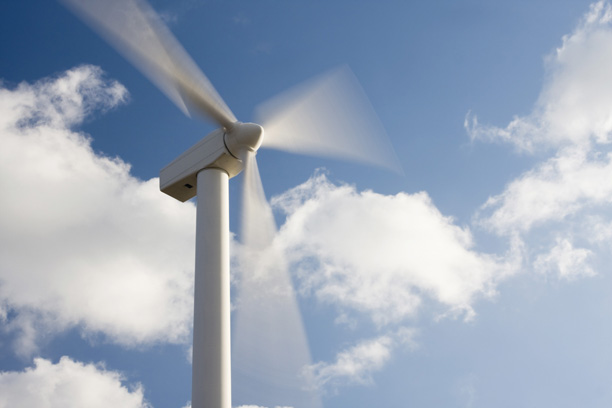In the past decade, the topics of energy production and storage have become a high priority for business and government, both of which have increased concerns relating to the environment and the sustainability of energy sources for the future. The latest policies are designed to reduce the use of fossil fuels in favor of clean, green electrical energy, and current government policy is designed to promote this approach by encouraging energy conservation and the utilization of more renewable energy sources for the production of electrical energy. With the shift toward renewable sources of energy such as wind and solar comes a new set of technical problems. The primary shortcoming of such sources of power is their intermittent nature. The history of power quality problems on the existing, aging system will only continue to worsen as intermittent, renewable energy systems are added. With intermittence comes the urgent need to develop reliable, fast-acting energy storage.

Chad Hall
Chief Operating Officer
Ioxus, Incorporated
The main source of stored energy is fossil fuel in its various forms. These include crude oil, natural gas, and coal, which are used to fuel all forms of transportation, as well as for the generation of electrical energy. Nuclear fuels are used to a lesser extent in the production of electrical energy. In 2008, for example, coal or natural gas-fueled plants produced approximately 70 percent of all electrical energy, whereas nuclear plants produced only about 20 percent. Both sources of fuel have fallen into disfavor due to environmental concerns and the unsustainable reality of fossil fuels. Recently, more emphasis has been put on wind and solar sources as favor shifts to renewable energy sources, which are perceived to have little or no environmental impact.
Symbiosis of Wind and Solar
In 2008, only about 3 percent of electrical energy in the United States was from renewable sources, but according to the American Wind Energy Association (AWEA), 20 percent of the nation’s supply of electrical energy will come from wind energy by 2030. In 2008 alone, an additional 8,500 MW of capacity was added, increasing the cumulative total of wind-generated electrical energy by nearly 50 percent.
Photovoltaic systems have not achieved the degree of prominence for commercial energy production as wind generation, however there are efforts underway to make it another potential of “green” energy. In the end, the sun shines during the day and the wind blows at night. Both have intermittency problems – the clouds reduce solar production and wind speed and direction changes constantly. A storage system with high “cycle-ability” and high energy and power density is required to provide stability to the system.

Demand Changes
The challenge to any commercial producer of electrical energy is the requirement to meet current demand, which is to a great extent because it is difficult and expensive to store electrical energy. Demand changes come in two flavors: long- and short-term. The long-term changes are those that occur at a gradual rate, illustrated by the summertime increase in demand that accompanies a period of sultry weather and resulting in the widespread use of air conditioners. This type of demand increase can be handled by the utility, provided it has sufficient capacity or can buy reserves from a neighboring utility via the grid network.
Far more ubiquitous are short-term increases in demand that result from a sudden change in load that might occur when large machinery is brought online in a manufacturing facility. Indeed, the majority of fluctuations occur for a period of less than two seconds, and such momentary changes in demand represent the biggest headache for utilities as they lead to reduced power quality.
The Power Quality Drain
Power quality is another major issue, as most customers require high power quality to ensure the proper operation of their equipment; in the 2007 report, Providing Power Quality for 21st Century Needs, the National Energy Technology Laboratory for the Department of Energy estimated that power quality problems cost U.S. companies more than $100 billion per year.
Power quality is also affected by the aging delivery infrastructure. The transmission lines in many areas are overloaded, leading to higher line and power losses due to reactance created by an ever-increasing inductive load. With the proliferation of more and more electronic devices and electric motors, inductive load is increasing, which in turn requires more and more reactive power to reduce the real power that is delivered by utilities.
This trend not only reduces profits to operators but also exacerbates the problems associated with the efficient delivery of quality power to the end user. The power grid in the United States can be thought of as three regional grids that are loosely connected. The Northeast portion, the Western portion, and Texas are more or less integrated grid networks, loosely coupled in the sense that they operate in a semi-autonomous fashion. Regulations have changed, and it would now be far more advantageous for independent system operators to have a fully integrated grid network so that power can be dispatched between locations that are separated by great distances. However, the grid that is currently in place is not integrated, and trying to use it as if it were is also a problem in terms of power quality.
The grid has evolved with no real long-range plan, and as a consequence, the current grid network is a patchwork of transmission lines. All things considered, it works remarkably well; however, unless the problems of the grid are addressed in the short term, the situation will worsen, resulting in more frequent and widespread power outages, reduced power quality and the possibility of equipment damage.
Plugging the Drain
If one makes the assumption that the electrical power grid is going to remain, at best, fragile for the foreseeable future, other methods for mitigating power quality losses must be considered. Two readily apparent methodologies that could alleviate this problem would be: 1) Reduce the demands placed on the grid infrastructure; and 2) consider alternatives that would allow end users (or localities) to improve power quality in ways that do not depend on the grid infrastructure. Ultracapacitors, in combination with either or both of the foregoing methodologies would function well with an associated power electronics interface to address the short-term interruptions.
Energy Storage Alternatives
Spinning reserve, pumped-hydro, flywheels, and high-pressure air are all used to provide energy storage to electrical utility operators.
Spinning Reserve
Spinning reserve is the practice of having a generating station running – but offline – until demand increases require additional generating capacity to be brought on line. Spinning reserve is expensive and inefficient, requiring the utility to use fuel to run a generating station that may be idling for long periods of time.
Pumped Hydro
The pumped-hydro method allows a utility to produce energy at a relatively constant rate and use periods of low demand to pump water into an elevated holding area; when demand increases, the water can be used to produce hydro electricity by recapturing the gravitational potential energy.
Flywheels
The flywheel system uses power during periods of low demand to put energy into flywheels whose energy is recaptured when demand increases, and in a like manner, high pressure air is accumulated when demand is low and used to drive a turbine under conditions of increased demand.
Smart Grid Enablement
But these methods all require specialized conditions and are expensive. For example, in the case of pumped-hydro storage, a facility with a large reservoir is required along with the ancillary hydro generating equipment. High-pressure air is generally stored in a large, natural cavern or abandoned mine, and as these are not readily available, the usefulness of this approach is limited. And flywheel farms require high maintenance causing several prototype facilities to be taken out of service for that reason. All of these methods have significant drawbacks, and due to their expense and limited availability, require a smart grid network to make them viable.
The investment, for example, in a high-pressure air system requires a cavern or abandoned mine, the installation of the machinery to operate the system, and a cost benefit analysis to ensure the system will be cost efficient. This will then require that the energy produced can be conveyed to regions of the country in need of the extra capacity and thus the need for a reliable and efficient grid network.
A Better Way
The systems described thus far are not portable, require an expensive infrastructure and added transmission, and are not efficient for addressing the short-term sags described above. More suitable solutions for short-term sags are batteries and/or ultracapacitors. Both are portable, allowing them to be installed in virtually any location or substation, are efficient for short-term sags, and provide for faster return-on-investment than large installations. It is relatively easy to build a megawatt of capacity using batteries, ultracapacitors, or a combination of both that will function well with an associated power electronics interface to address the short-term interruptions previously mentioned.
The parallel combination has both high energy and power density. Ultracapacitors, like all capacitors, have a high power density. What differentiates ultracapacitors from their traditional counterparts, electrolytic capacitors, is their high energy density, allowing them to store a vast amount of energy in a small package. The capacitors with which most design engineers are familiar have short time constants, which mean that their voltage cycles quickly.
By contrast, ultracapacitor arrays have time constants of the order of tens of seconds to minutes. The large capacitance and extremely low frequency time constants allow ultracapacitors to be used in applications that have not been practical or economical for other types of capacitors. Using such supplies in concert with power electronic techniques make the design and cost of power conditioning equipment available to most volume users of electrical energy. As the sophistication of power conditioners increases, their costs will come down, and it is possible such systems will be available for a much wider spectrum of power consumers. Since ultracapacitors have a much lower internal resistance and much faster charge rate than batteries, they can make a battery-powered system run much more efficiently.
An array of ultracapacitor cells in series coupled to a load in parallel with a storage battery creates a hybrid power source with higher power and energy density than either device in a stand-alone configuration. By gradually taking on a load, batteries are insulated from high current drains that cause thermal, chemical, and mechanical stresses.
By reducing current spikes, the internal temperature of batteries is decreased substantially, extending the life of the batteries by as much a 400 percent, depending on the application. Additionally, there are times when a battery simply cannot deliver the current needed for an application, and in particular when you need to continually charge and discharge, such as is needed for load leveling. Conversely, there are times when an ultracapacitor alone will not work, in particular when there is a need for extended discharge for minutes or hours.
Conclusion
As the electrical infrastructure evolves to utilize renewable sources of energy, the arsenal of storage devices will need to be increased. With this increase in renewable energy sources of electrical energy, it is apparent that solutions will be required to include an intermediate storage media that can function in the short term and longer term increase in demand, making the production of local electrical energy more practical. Financial drivers dictate this trend; local production that utilizes renewable sources will go a long way to relieve stress on the grid infrastructure and will use resources more efficiently. In order to make this a reality, it will be necessary to develop robust energy storage media that will likely include improved batteries and high-energy density ultracapacitors.
About the Author
Chad Hall is the chief operating officer of Ioxus, Inc. He previously spent 14 years with Ioxus’ parent company, Custom Electronics, Inc. His extensive mechanical engineering and business experience helped establish Ioxus from funding to factory to launch. Chad can be reached via email at chall@ioxus.com or at www.ioxus.com.







